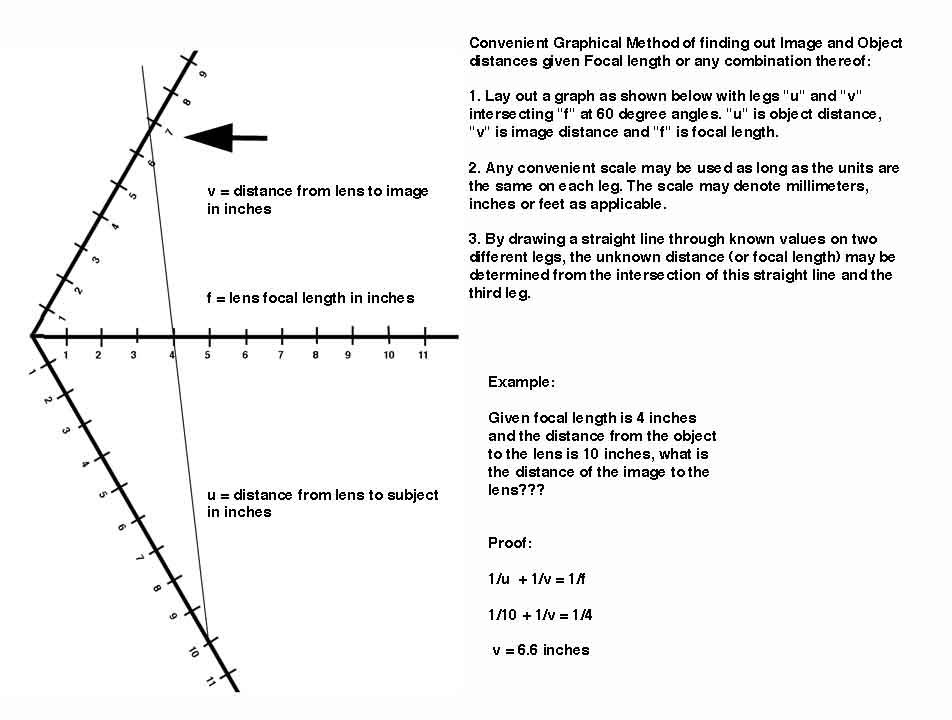Graphical determination of Focal Length and Image
and
Object distances
Andrew Davidhazy
Images for Science, Education, Industry
andpph@davidhazy.org
andpph.com
Andrew Davidhazy
Images for Science, Education, Industry
andpph@davidhazy.org
andpph.com
This is a graph that I found among
my salvaged papers from ages ago. I thought it would be useful to
someone and that is the reason I am including it here. I think this
graphical method is actually common knowledge (among those who have
this in their background!!) but it never hurts to have it available
elsewhere. One never knows when a tidbit of knowledge might come in
handy. So here it is with nothing further to add.

One first places a ground glass at the image side of the lens and adjusts its position so that the lens makes a sharply focused image of a distant object on the ground glass. The next step is to turn the lens from side to side and if the image of the distant object does not move on the ground glass as the lens is pivoted, then the axis of rotation is located at the rear (or image side) nodal point of the lens. If the image does move then readjust the position of the lens in the holder so it rotates about a different axis. This calls fro an adjustment of the location of the ground glass as well. Experience will guide you I am sure.
To find the other nodal point one turns the lens around and performs the same procedure. It will be seen that there is a small difference in position between the two axes of rotation. The one closest to the front of the lens is called the front nodal point and the one closest to the rear of the lens is the rear nodal point. The distance between them is the internodal distance. It is a "magic" distance as it essentially not considered in image-object distance measurements. It is as if the two merge into one. Focal length is measured from the rear nodal point to the sharply focused image of an object at infinity (when it does not move as the lens is rotated about the rear nodal point) and the object distance from the front nodal point to the object.
It is "obvious" therefore that if a camera that has a fixed lens attached, or one that accepts interchangeable lenses (not a view camera), and if it is set on infinity focus and you measure forward from the image plane one focal length you will, in fact have located the rear nodal point of the lens.
You can reverse the lens and make a sharply focused image of a distant object and again measure away from the focal plane one focal length and you will locate the front nodal point. This is a bit harder to do because when you reverse the lens there is no mechanical coupling between the camera body and the lens itself.
HOWEVER ALSO NOTE: Note that the distance that a lens is focused on is indicated on most cameras as measured from the focal plane and not the nodal point(s). Object distance to a subject based on the lens's focusing scale is measured from the film or sensor plane within the camera. It can be easily located on most cameras because it is indicated by a small circle crossed with a line. The line is the location of the film or sensor plane and if you are attempting to focus the lens by its focusing scale then you would measure forward from that line to the subject.
All bets are off if you focus on the ground glass or similar device in a DSLR or use the electronic viewfinder (such as Live View) of a camera equipped with such a device. In that case you simply focus the subject as you see it in such a finder.
You may find that the distance indicator on the lens does not agree with the measured distance from the image line inscribed on the camera body. This is quite normal and will probably only be noticeable at very short subject distances and it is a result of the fact that the inter-nodal distance is not a factor when you focus on a ground glass or equivalent but it is a factor when you simply measure from the film or sensor plane to the subject.
OK, I am going out on a slight limb here as I have not worked with nodal slides and such for some time and my memory may have failed me as I put this text together. I would much appreciate it if you have read this and find fault with anything stated here that you please let me know so that I may correct the text to reflect reality. Thank you.
You
can contact me, Andrew Davidhazy, by email at: andpph@davidhazy.org